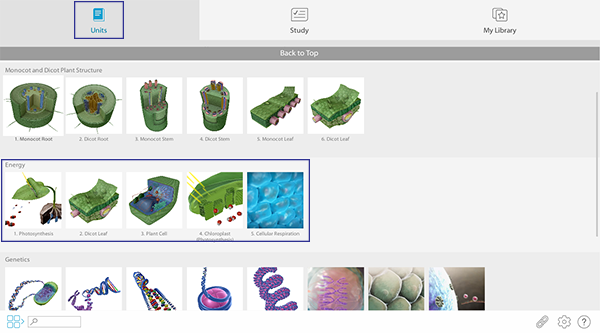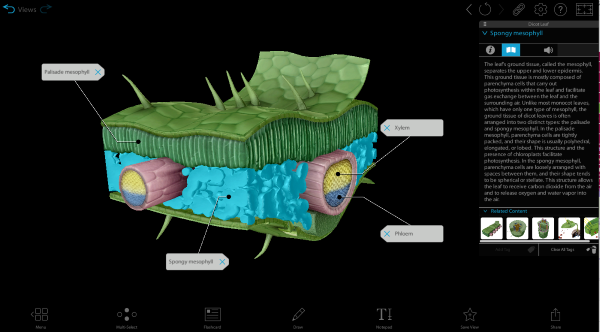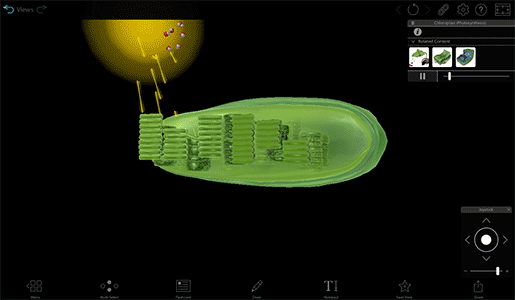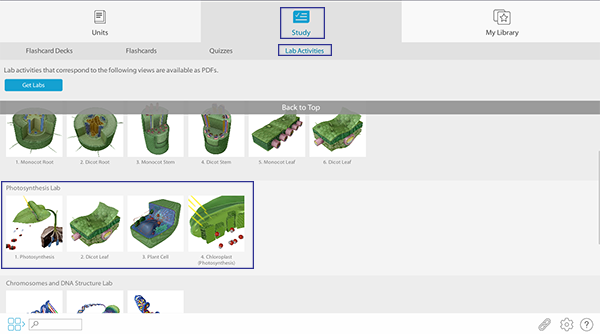Teaching Photosynthesis with Visible Body: A Free Lesson Plan
Posted on 10/8/21 by Laura Snider
In any introductory biology class, photosynthesis is a big topic—that’s hardly surprising, given just how important photosynthesis is to all life on Earth! It can also be challenging to teach, since there’s so much information students need to not just memorize but understand, from plant structures to chemical equations.
Fortunately, Visible Body Suite's got you covered! Today, we’ll walk you through a free lesson plan and set of lab activities on photosynthesis.
Ultimately, after finishing the lesson and labs, students should be able to answer these three questions:
- What are the reactants and products of photosynthesis? What is the photosynthesis equation?
- Why is photosynthesis important for a plant’s survival?
- What are the main steps in the process of photosynthesis?
1. Introduce the reactants and products of photosynthesis
Our lesson plan begins with a zoomed-out view of photosynthesis—identification of the reactants and products. If you want to assign some before-class reading on this topic, the Reactants and Products article on Visible Body’s Biology Learn Site and the Photosynthesis Overview chapter of OpenStax’s Concepts of Biology are both good resources.
You can have students use the Photosynthesis interactive simulation in VB Suite to identify the following:
- carbon dioxide (CO2) molecules
- a glucose (C6H12O6) molecule
- oxygen (O2) molecules
- photons of light
- water (H2O) molecules

Photosynthesis models and simulations in the Energy Unit in VB Suite.
These animated 3D models show how each reactant enters the plant, and what happens to each (by)product.
All of Visible Body's biology content is now exclusively available in VB Suite!
2. Walk through the roles of plant structures involved in photosynthesis
Next, use the dicot leaf 3D model in VB Suite to show students the leaf structures they’ll need to know:
- The upper and lower epidermis that contain the stomata and their guard cells
- The palisade and spongy mesophyll, where photosynthesis takes place
- The phloem and xylem, which move nutrients and water through the plant.
For more information on these structures, students can read the Leaf Structures Involved in Photosynthesis article on the Biology Learn Site.
 The dicot leaf model in VB Suite. The palisade mesophyll, spongy mesophyll, xylem, and phloem are labeled with tags and the spongy mesophyll is highlighted.
The dicot leaf model in VB Suite. The palisade mesophyll, spongy mesophyll, xylem, and phloem are labeled with tags and the spongy mesophyll is highlighted.
3. Get into more detail with light-dependent and light-independent reactions inside the chloroplast
For those instructors who want to give students a more detailed look at the chemical reactions taking place during photosynthesis, the chloroplast simulation in VB Suite shows the light-dependent and light-independent reactions of photosynthesis, as well as the internal structures of the chloroplast where these reactions occur.
Students will be able to identify the following:
- The reactants and products of photosynthesis as well as chlorophyll
- The inner and outer membrane of the chloroplast
- The stroma
- Thylakoids, organized into grana
They will also be able to see how oxygen is produced when water molecules are broken down in the light-dependent reactions, and how the light-independent reactions use carbon dioxide to produce glucose.

Video footage of the chloroplast simulation in VB Suite.
Students can brush up on their knowledge of these structures and processes by reading the Light-Dependent and Light-Independent Reactions of Photosynthesis article on the Biology Learn Site. The Light-Dependent Reactions of Photosynthesis and Calvin Cycle chapters of OpenStax Concepts of Biology are also great background reading. If you want to introduce students to how photosynthesis compares to and relates to cellular respiration, check out this post from the Visible Body Blog.
4. Check students' knowledge with Lab 1: Plant Structures, Reactants, and Products of Photosynthesis
Now that your students have completed the introductory lessons and readings, it’s time to assess their understanding of photosynthesis with this first lab. The official VB lab contains five activities, which take about 45 minutes total to complete. There is also a set of more general background questions, which could be assigned as pre-lab homework along with the reading and structure identification lessons. Students can conveniently access the photosynthesis models for help during the lab activities with the Study tab in VB Suite.

The photosynthesis simulations and models students will need for the photosynthesis lab activities are located in the Lab Activities section under the Study tab in VB Suite.
In Lab 1, students will review what they learned about products and reactants and plant structures from the reading and from the 3D models and simulations. They will need to label the following:
- The reactants and products of photosynthesis
- The leaf structures involved in photosynthesis
- A chloroplast within a plant cell
- The internal structures of a chloroplast
They will also be asked to match different plant structures to their roles in photosynthesis and to complete a chart detailing each product, reactant, and step of photosynthesis.
5. Observe photosynthesis with Lab 2: Floating Leaf Disk Experiment
Once students have a thorough understanding of the reactants and products of photosynthesis, as well as the structures of the plant that allow it to occur, the floating leaf disk experiment will show them photosynthesis in action and lead them to deduce the conditions under which it can occur. Check out this video to see an overview of the procedure for the floating leaf disk experiment activity.
In this lab, students will submerge leaf disks in different solutions and environments (a bicarbonate solution in light conditions, a bicarbonate solution in dark conditions, and distilled water in light conditions). They will then measure how many leaf disks sink and how many remain floating at the end of each minute for 20 minutes. Afterwards, they will graph their results and answer several short answer questions to evaluate their significance.
6. Put it all together with Lab 3: Photosynthesis in the Chloroplast
The final lab activity gives students the chance to demonstrate their knowledge of photosynthesis by drawing a chloroplast and illustrating the light-dependent and light-independent reactions. They will need to explain the process of photosynthesis and its equation in their own words, showing that they understand each component and step.
All in all, VB Suite's content and lab activities bring the process of photosynthesis to life and put students in the driver’s seat, letting them manipulate 3D models and simulations to find the answers they need, helping them draw connections to other biology topics (like cellular respiration), and engaging their writing and critical thinking skills to explain what they’ve learned.
You can download the lesson plan and lab activities here. For a free instructor trial, contact our Education Team. Happy teaching!
NGSS Standards
The above lesson plan fits these Next Generation Science Standards (NGSS):
HS-LS1 From Molecules to Organisms: Structures and Processes. Students who demonstrate understanding can:
- Develop and use a model to illustrate the hierarchical organization of interacting systems that provide specific functions within multicellular organisms. (HS-LS1-2)
- Use a model to illustrate how photosynthesis transforms light energy into stored chemical energy. (HS-LS1-5)
HS-LS2 Ecosystems: Interactions, Energy, and Dynamics. Students who demonstrate understanding can:
- Develop a model to illustrate the role of photosynthesis and cellular respiration in the cycling of carbon among the biosphere, atmosphere, hydrosphere, and geosphere. (HS-LS2-5)
Did you know that the Visible Body Education Team has created a library of lesson plans and lab activities? Here's where you can find these resources, complete with NGSS standards.
Be sure to subscribe to the Visible Body Blog for more anatomy awesomeness!
Are you an instructor? We have award-winning 3D products and resources for your anatomy and physiology course! Learn more here.
https://www.visiblebody.com/blog/teaching-photosynthesis-with-visible-biology-a-free-lesson-plan


